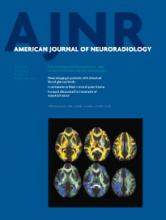Abstract
BACKGROUND AND PURPOSE: Intracranial hemorrhage is the most severe complication of brain arteriovenous malformation treatment. We report our rate of hemorrhagic complications after endovascular treatment and analyze the clinical significance and potential mechanisms, with emphasis on cases of delayed hemorrhage after uneventful embolization.
MATERIALS AND METHODS: During a 10-year period, 846 embolization procedures were performed in 408 patients with brain AVMs. Any cases of hemorrhagic complications were identified and divided into those related or unrelated to a periprocedural arterial tear (during catheter navigation or catheter retrieval). We analyzed the following variables: sex, age, hemorrhagic presentation, Spetzler-Martin grade, size of the AVM, number of embolized pedicles, microcatheter used, type and volume of liquid embolic agent injected, and the presence of a premature venous occlusion. Univariate and multivariate multiple regression analyses were performed to identify risk factors for hemorrhagic complications.
RESULTS: A hemorrhagic complication occurred in 92 (11%) procedures. Forty-four (48%) complications were related to a periprocedural arterial perforation, and 48 (52%) were not. Hemorrhagic complications unrelated to an arterial perforation were located more commonly in the cerebral parenchyma, caused more neurologic deficits, and were associated with worse prognosis than those in the arterial perforation group. Only premature venous occlusion was identified as an independent predictor of hemorrhagic complication in the nonperforation group. Premature venous occlusion was significantly related to the ratio of Onyx volume to nidus diameter.
CONCLUSIONS: Higher injected volume of embolic agent and deposition on the venous outflow before complete occlusion of the AVM may account for severe hemorrhagic complications.
ABBREVIATIONS:
- AP
- arterial perforation
- EVT
- endovascular treatment
- HC
- hemorrhagic complication
- NAP
- non-arterial perforation
- S-M
- Spetzler-Martin
- Vea
- volume of liquid embolic agents
- © 2014 by American Journal of Neuroradiology












